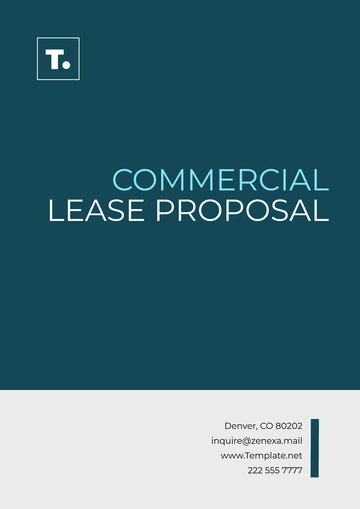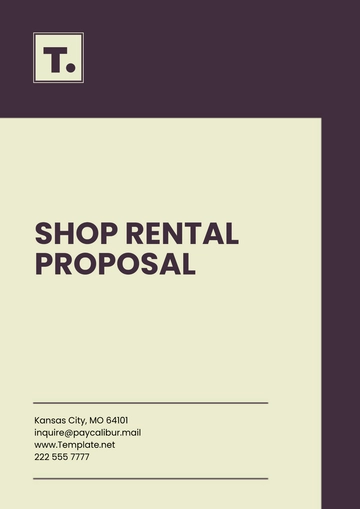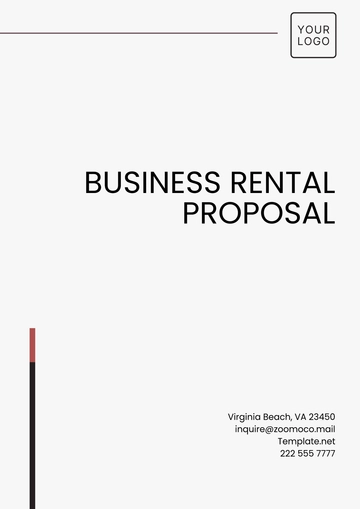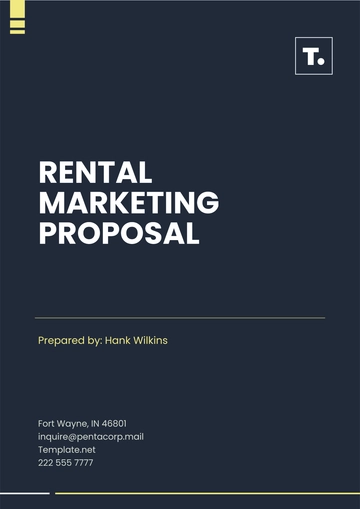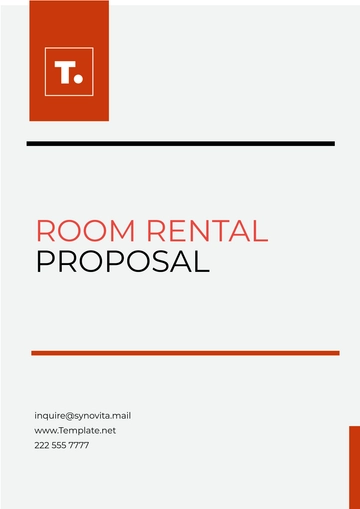Free Car Rental Work Proposal

I. Introduction
A. Purpose
The purpose of this Car Rental Work Proposal ("Proposal") is to outline the tasks, timelines, and resources required to implement a comprehensive car rental program that meets the needs of our customers and supports our business objectives.
B. Objectives
Our primary objectives are to establish a reliable and customer-focused car rental service, ensure efficient operations, and achieve sustainable growth in the car rental market.
C. Scope
This Proposal covers all aspects of the car rental program, including vehicle procurement, customer service, marketing, and operations.
II. Project Overview
A. Project Description
This project involves setting up a car rental service with a diverse fleet of vehicles, implementing customer service protocols, and marketing the service to attract and retain customers.
B. Key Deliverables
The key deliverables for this project include:
Acquisition of a diverse fleet of vehicles.
Implementation of customer service protocols.
Development of a marketing strategy.
Establishment of operational procedures.
III. Work Breakdown Structure
A. Vehicle Procurement
1. Vehicle Selection
The vehicle selection process starts by identifying market needs through customer preference research and competitor analysis. This helps determine in-demand vehicle types, such as economy, luxury, and SUVs. Evaluations focus on aspects like fuel efficiency, safety features, and maintenance costs. A cost analysis calculates total ownership costs and resale value. Test drives and inspections ensure quality and reliability. Finally, a list of vehicles is finalized, detailing specifications for acquisition.
Vehicle Type | Description | Quantity |
|---|---|---|
Economy | Compact cars, fuel-efficient | 20 |
Standard | Mid-size cars, comfortable | 15 |
SUV | Spacious, suitable for families | 10 |
Luxury | High-end cars, premium features | 5 |
Truck/Van | For cargo and group travel | 10 |
2. Supplier Negotiations
Supplier negotiations begin by researching and shortlisting reputable suppliers who can meet company needs. Next, suppliers are evaluated based on pricing, terms, and delivery schedules. Detailed negotiations aim for cost efficiency and favorable conditions, leading to finalized contracts. Strong relationships and continuous communication ensure a smooth supply chain.
3. Fleet Acquisition
Fleet acquisition includes purchasing or leasing vehicles from a selected list. It starts with budget planning and securing financing, followed by placing orders with suppliers. Upon delivery, vehicles are inspected, registered, and documented. Lastly, they are entered into the fleet management system for tracking and maintenance.
B. Customer Service
1. Training
Training is vital for employee preparedness, starting with an initial phase that includes orientation, hands-on experience, and online modules. Orientation covers the company's mission and procedures, while on-the-job training offers practical experience. Formal sessions address customer service, safety, vehicle maintenance, and compliance. Regular and annual refreshers keep employees up-to-date.
2. Customer Support Systems
Effective customer support requires a dedicated, well-trained team, advanced CRM tools, multiple communication channels, and regular training sessions to ensure exceptional service.
Support Channel | Implementation Timeline |
|---|---|
Phone Support | 2 weeks |
Email Support | 1 week |
Online Chat | 3 weeks |
3. Feedback Mechanisms
Effective feedback mechanisms are key for continuous improvement. Customers are urged to offer feedback via surveys, reviews, and direct contact, which is analyzed to pinpoint improvement areas. Regular employee feedback sessions address customer input to create action plans. Implementing changes boosts customer satisfaction and operational efficiency.
C. Marketing Strategy
1. Market Research
Marketing research collects and analyzes data on market trends, customer behavior, and competition. It begins with setting objectives and creating a research plan. Data is gathered via surveys, focus groups, and existing market analysis, and then analyzed to inform marketing strategies. This ongoing process helps the company stay ahead of trends and effectively target customers.
2. Marketing Campaigns
Launching effective marketing campaigns is vital for attracting and retaining customers. This involves setting objectives, identifying target audiences, crafting resonant messages, choosing channels like social media and digital ads, and monitoring performance for optimization. Post-campaign analysis measures effectiveness to improve future efforts.
Marketing Channel | Budget | Timeline |
|---|---|---|
Digital | $20,000 | 3 months |
$10,000 | 2 months | |
Events | $15,000 | 6 months |
3. Brand Development
Brand development aims to create a strong, recognizable brand through defining its mission, values, and USPs. Visuals like logos and color schemes shape its identity, while consistent messaging conveys its personality. It also involves ongoing marketing and customer engagement to build awareness and loyalty.
D. Operations
1. Operational Procedures
Creating and maintaining SOPs ensures efficient service delivery. This includes documenting procedures for vehicle check-in/out, maintenance schedules, and customer service. Regular reviews update these procedures with best practices and operational improvements. Employees are trained to follow them.
2. Technology Implementation
Efficient operations rely on the right technology, like fleet management software, CRM tools, and payment systems. This entails selecting, deploying, configuring, training, and integrating these systems, with ongoing support to keep them effective and aligned with business goals.
Technology | Vendor | Cost | Timeline |
|---|---|---|---|
Fleet Management | $25,000 | 2 months | |
Booking System | $15,000 | 1 month | |
Payment Processing | $10,000 | 3 weeks |
3. Compliance and Safety
Ensuring compliance and safety is our top priority. We stay updated on relevant regulations and train employees accordingly. Safety protocols are regularly reviewed, and audits/inspections are conducted to maintain standards.
IV. Project Timeline
The project will span four months. Here is a timeline of all key milestones.
Milestone | Expected Completion Date |
|---|---|
Project Kickoff | Week 1 |
Vehicle Procurement Completion | Week 6 |
Customer Service Training | Week 8 |
Marketing Campaign Launch | Week 10 |
Operations Setup Completion | Week 12 |
Service Launch | Week 14 |
V. Budget
A. Estimated Costs
This section provides a comprehensive breakdown of the project's estimated costs.
Component | Estimated Cost |
|---|---|
Vehicle Procurement | $500,000 |
Customer Service | $50,000 |
Marketing | $45,000 |
Technology | $50,000 |
Operations | $30,000 |
Contingency | $25,000 |
Total | $700,000 |
B. Funding Sources
We have identified funding sources to support this project. Here are the details.
Funding Source | Amount |
|---|---|
Internal Funds | $300,000 |
Bank Loan | $200,000 |
Investor Funding | $200,000 |
VI. Risk Management
This section highlights the key risks that could impact the project.
Risk | Likelihood | Impact |
|---|---|---|
Supplier Delays | Moderate | High |
Budget Overruns | Low | Moderate |
Market Competition | Moderate | High |
To address the risk of budget overrun, we will implement strict budget monitoring and control mechanisms, including regular financial reviews and variance analysis. We will also establish contingency reserves to cover unexpected expenses and conduct frequent cost-benefit analyses to ensure efficient allocation of resources.
To mitigate the risk posed by competition, we will focus on differentiating our services through exceptional customer service, innovative marketing strategies, and loyalty programs. We will continuously monitor market trends and competitor activities to adapt and stay ahead.
In case of supplier delays, we will develop strong relationships with multiple suppliers to diversify our supply chain and reduce dependency on any single source. Additionally, we will negotiate favorable terms that include penalties for delays and maintain an adequate inventory buffer to manage any disruptions smoothly.
VII. Evaluation and Monitoring
This section outlines the key metrics that will be used to measure project success.
Metric | Target |
|---|---|
Customer Satisfaction | 90%+ |
Fleet Utilization Rate | 80%+ |
Revenue Growth | 15%+ per quarter |
Monthly review meetings will involve key stakeholders to ensure project alignment and timely issue identification. We'll evaluate progress, budget adherence, and performance using status reports and data, and develop corrective actions as needed. Employee and customer feedback will be included for a comprehensive project assessment.
VIII. Call to Action
We invite stakeholders to review this Proposal and provide feedback. With collaborative efforts and a shared commitment to excellence, we can achieve our goals and deliver exceptional value to our customers.
- 100% Customizable, free editor
- Access 1 Million+ Templates, photo’s & graphics
- Download or share as a template
- Click and replace photos, graphics, text, backgrounds
- Resize, crop, AI write & more
- Access advanced editor
Car Rental Work Proposal Template from Template.net offers an editable and customizable solution for presenting project plans. Editable in our AI Editor tool, this template allows you to detail tasks, timelines, and resources for your car rental services. Ensure clarity and professionalism in your work proposals with this versatile and user-friendly template.
You may also like
- Business Proposal
- Research Proposal
- Proposal Request
- Project Proposal
- Grant Proposal
- Photography Proposal
- Job Proposal
- Budget Proposal
- Marketing Proposal
- Branding Proposal
- Advertising Proposal
- Sales Proposal
- Startup Proposal
- Event Proposal
- Creative Proposal
- Restaurant Proposal
- Blank Proposal
- One Page Proposal
- Proposal Report
- IT Proposal
- Non Profit Proposal
- Training Proposal
- Construction Proposal
- School Proposal
- Cleaning Proposal
- Contract Proposal
- HR Proposal
- Travel Agency Proposal
- Small Business Proposal
- Investment Proposal
- Bid Proposal
- Retail Business Proposal
- Sponsorship Proposal
- Academic Proposal
- Partnership Proposal
- Work Proposal
- Agency Proposal
- University Proposal
- Accounting Proposal
- Real Estate Proposal
- Hotel Proposal
- Product Proposal
- Advertising Agency Proposal
- Development Proposal
- Loan Proposal
- Website Proposal
- Nursing Home Proposal
- Financial Proposal
- Salon Proposal
- Freelancer Proposal
- Funding Proposal
- Work from Home Proposal
- Company Proposal
- Consulting Proposal
- Educational Proposal
- Construction Bid Proposal
- Interior Design Proposal
- New Product Proposal
- Sports Proposal
- Corporate Proposal
- Food Proposal
- Property Proposal
- Maintenance Proposal
- Purchase Proposal
- Rental Proposal
- Recruitment Proposal
- Social Media Proposal
- Travel Proposal
- Trip Proposal
- Software Proposal
- Conference Proposal
- Graphic Design Proposal
- Law Firm Proposal
- Medical Proposal
- Music Proposal
- Pricing Proposal
- SEO Proposal
- Strategy Proposal
- Technical Proposal
- Coaching Proposal
- Ecommerce Proposal
- Fundraising Proposal
- Landscaping Proposal
- Charity Proposal
- Contractor Proposal
- Exhibition Proposal
- Art Proposal
- Mobile Proposal
- Equipment Proposal
- Student Proposal
- Engineering Proposal
- Business Proposal








